| |
|
|
|
Edward Alva Sharrock
Specialist Four
A CO, 5TH BN, 7TH CAVALRY, 1ST CAV DIV, USARV Army of the United States Bucyrus, Ohio October 21, 1947 to March 23, 1968 (Incident Date February 12, 1968) EDWARD A SHARROCK is on the Wall at Panel 46E, Line 1 See the full profile or name rubbing for Edward Sharrock |
  |
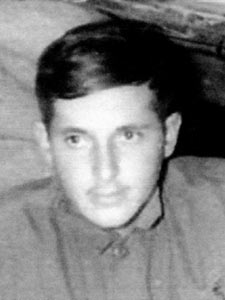
|



| |
|
Battle for Hue - 1968
The plan for the 1968 Tet Offensive was born in the summer of 1967. Frustrated with the stalemate on the battlefield and concerned with aggressive American tactics during previous year, Communist leaders in Hanoi decided to launch a general offensive to strike a decisive blow against the South Vietnamese and their U.S. allies. This campaign was designed to achieve three objectives: provoke a general uprising among the people in the South, shatter the South Vietnamese armed forces, and convince Americans that the war was unwinnable. The offensive would target the previously untouched South Vietnamese urban centers. The Communists prepared for the coming offensive by a massive buildup of troops and equipment in the south. At the same time they launched a series of diversionary attacks against remote outposts designed to lure U.S. forces away from the population areas. In the fall of 1967, the plan went into effect with Communist attacks in the areas south of the Demilitarized Zone (DMZ) separating Vietnam's two sections and along South Vietnam's western border in the Central Highlands. The main effort of this preliminary phase of the offensive began on 21 January 1968 at Khe Sanh in northwestern South Vietnam. With all eyes on Khe Sanh, the Communists launched the main offensive itself in the early morning hours of January 31, 1968, when 84,000 North Vietnamese and VC troops, taking advantage of the Tet (lunar New Year) ceasefire then in effect, mounted simultaneous assaults on 36 of 44 provincial capitals, the 6 autonomous cities, induding Saigon and Hue, 64 of 242 district capitals, and 50 hamlets. Many of the South Vietnamese troops were on holiday leave, so the Communist forces initially enjoyed widespread success. The longest and bloodiest battle of the Tet Offensive occurred in Hue, the most venerated place in Vietnam. The battle began on 31 January. The only U.S. military presence in Hue when the battle began was the MACV (Military Assistance Command, Vietnam) compound, which housed 200 U.S. Army, U.S. Marine Corps, and Australian officers and men who served as advisers to the 1st ARVN Division. When the sun came up on the morning of January 31, nearly everyone in the city could see the gold-starred, blue-and-red National Liberation Front flag flying high over the Citadel. On the evening of 31 January the 3rd, reinforced by the 2nd, 7th, and 9th ARVN airborne battalions, ARVN Forces arrived in Hue. They mounted an attack to retake the Citadel and north bank of the river. By dawn the next day, the Peoples Army of VietNam (PAVN) held the south part of the city, including Gia Hoi and the southern half of the Citadel. The U.S. was restricted on mobility because of the nature of urban fighting and was not able to utilize its advantage in firepower due to the wish to not damage Hue. On February 2, the U.S. Army 1st Cavalry Division's 3rd Brigade entered the battle with the mission of blocking the enemy approaches into the city from the north and west. The brigade airlifted the 2nd Battalion, 12th Cavalry (2/12th Cav), into a landing zone about 10 kilometers northwest of Hue on Highway 1. By February 4, the cavalry troopers had moved cross country from the LZ and established a blocking position on a hill overlooking a valley about six kilometers west of Hue. This position provided excellent observation of the main enemy routes into and out of Hue. During the same period, the 5th Battalion, 7th Cavalry (5/7th Cav) conducted search and clear operations along enemy routes west of Hue. On 7 February, they made contact with an entrenched North Vietnamese force and tried for the next 24 hours to expel the communists. However, the enemy held their position and stymied the Cavalry advance with heavy volumes of automatic weapons and mortar fire. On 9 February, Headquarters 3rd Brigade, 1st Cavalry Division, ordered 5/7th Cav to fix the PAVN in place, while directing 2/12 Cav to attack northward from its position. The 2/12th ran into heavy resistance near the village of Thong Bon Tri, but continued to fight its way 5/7th Cav's position. For the next ten days, the two cavalry battalions fought with the entrenched communists, who held their positions against repeated assaults. Despite the inability of the cavalry troopers to expel the North Vietnamese, this action at least partially blocked the enemy's movement and inhibited their participation in the battle raging in Hue. Earlier, on 4 February, the Marines, with the support of Naval gunfire, began to fight house-to-house to clear the south bank. Finally on 11 February, the 1st Battalion, 5th Marines crossed the river to join the fight for the Citadel. The ARVN Division, reinforced by the VNMC and the Marines, fought house-to-house until on 21 February they met up with the 1st Cavalry Division which had been attacking from the west. For almost three weeks, the U.S. cavalry units tried to hold off the reinforcement of Hue by North Vietnamese troops from the PA VN 24th, 29th, and 99th Regiments. They were reinforced on 19 February, when the 2nd Battalion, 5Olst Infantry (2/501st) was attached to the 3rd Brigade, 1st Cavalry Division, from the U.S. Army's 101st Airborne Division. The battalion was subsequently ordered to seal access to the city from the south. Also on that day, the 1st Battalion, 7th Cavalry (1/7th Cav), relieved from its base defense mission at Camp Evans, deployed south to the Hue area. While these U.S. Army units saw plenty of heavy action in these outlying areas and contributed greatly to the eventual allied victory at Hue, the fighting inside the city was to remain largely in the hands of South Vietnamese troops and U.S. Marines. On 25 February, ARVN troops found that PAVN troops had deserted the Imperial Palace. At the end of this bloody battle, about half the city was destroyed. Thousands were homeless and as many as 5,700 had been executed by the Communists. This battle helped change the attitude of the population against the Communists. There were 89 PAVN/VC POWs. During this period the 5th Battalion, 7th Cavalry Regiment lost 29 men from 31 January to 28 February 1968; the 2nd Battalion, 12th Cavalry Regiment 39 lost men. The men from the 7th Cavalry were: 5th Battalion, 7th Cavalry Regt, 1st Cavalry Division (Airmobile)Thursday, February 8, 1968, (B Company)
From February 14th to the 16th, area newspapers published notices similar to the following announcing that Edward had been killed in Vietnam: 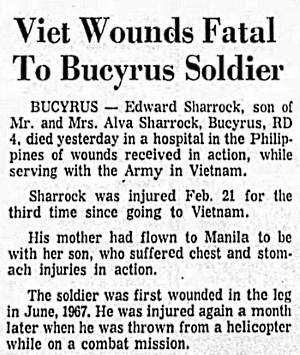
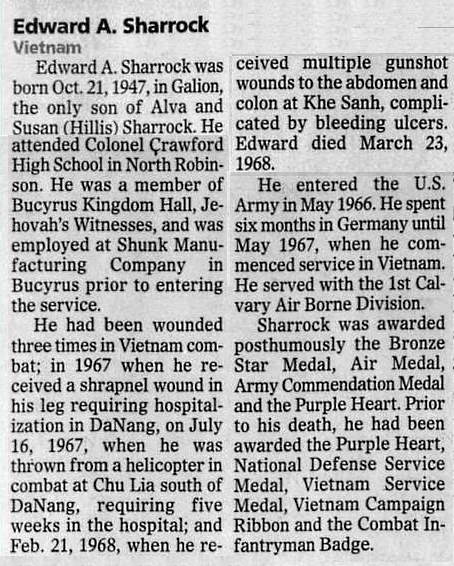
News-Journal (Mansfield, Ohio),
Saturday, 30 Mar 1968, Page 11
Rites Set For Vietnam Casualty
BUCYRUS - Services for Army Specialist Edward A. Sharrock, 20, of Bucyrus, RD 3, who died March 22 of wounds received in Vietnam combat, will be held at 2 p.m. Monday in the Kubach Funeral Home, Galion. Willard Light will officiate. Sharrock, the son of Mr. and Mrs. Alva Sharrock, died in the Clark AFB Manila Hospital in the Phillipines. He was wounded Feb. 21. It was the third time the soldier had been wounded. He was first wounded in June 1967 and again in August 1967. His mother was with him in the Phillipines when he died. He entered the army May, 19G6 and had served six months in Germany before being sent to Vietnam in May, 1967. A native of Galion, he at tended Colonel Crawford High School. He was last employed at Shunk Manufacturing Co. He was a member of Kingdom Hall, Jehovahs Witnesses, Bucyrus. Surviving besides his parents are five sisters, Mrs. Randall (Sandra) Vance of Marion, Mrs. Carl (Sharon) Wildenthaler of Galion, Mrs. James (Jacqueline) Blaine of Sandusky, Mrs. Fred (Billie) Wieland of Bucyrus and Miss Debra Sharrock at home. Burial will be in the Fairview Cemetery, Galion. Friends may call after noon Friday at the funeral home. Eight (8) months after the death of SP4 Edward Alva Sharrock on March 23, 1968, in the Phillipines, his parents received the medals that Edward was awarded from his Vietnam Service. He entered the country May 23, 1967 and was wounded during the Battle of Hue on February 12,1968. 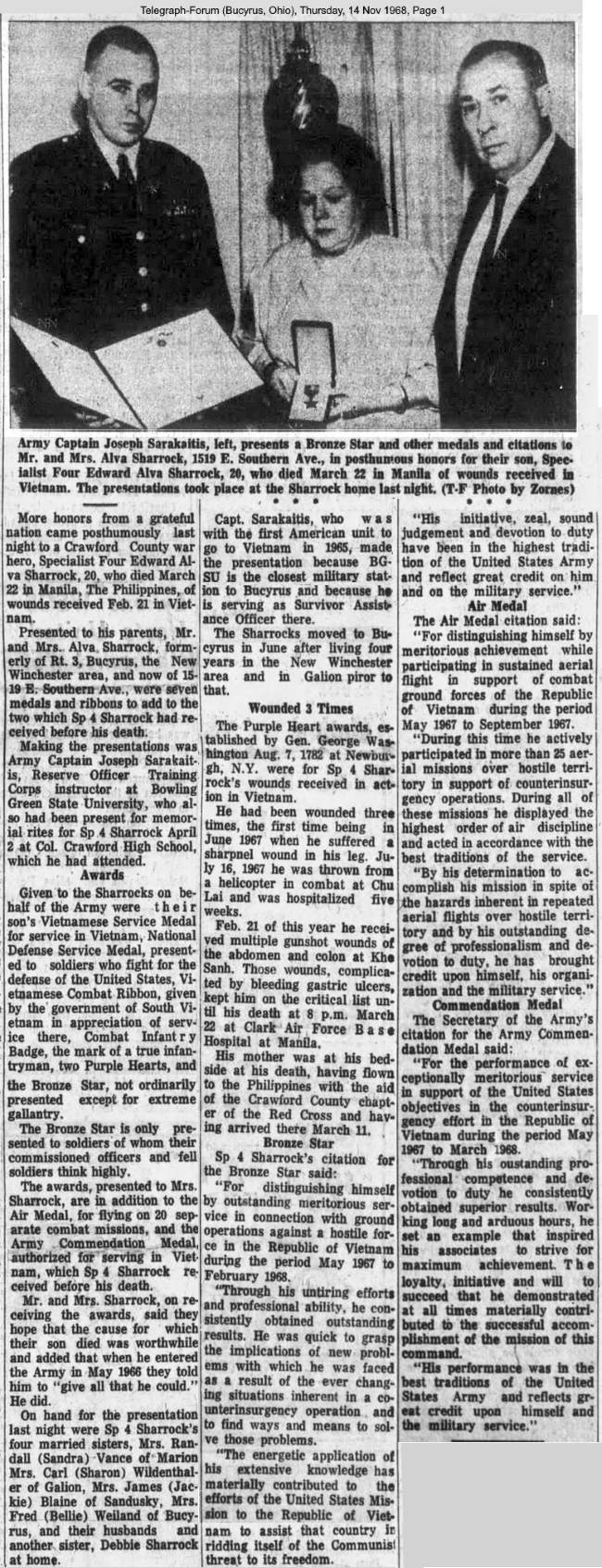
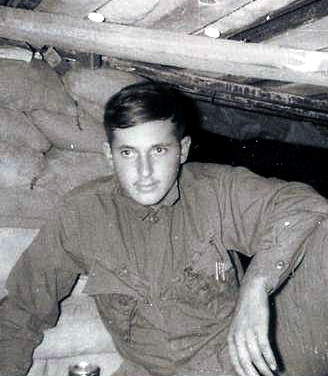
Edward Alva Sharrock was buried with his mother, Susan Arlene (Hillis) Sharrock (1915-2007), his father, Alva Edward Sharrock (1914-1969), along with both sets of grandparents, Maud L. and Elza S. Sharrock, and Amy L. and William D. Hillis. They are in the Fairview Cemetery, Galion, Crawford County, Ohio. 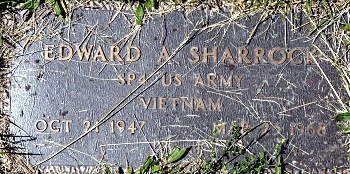
- - The Virtual Wall, 12 January 2020
|
| Contact Us | © Copyright 1997-2019 www.VirtualWall.org, Ltd ®(TM) | Last update 01/23/2020 |